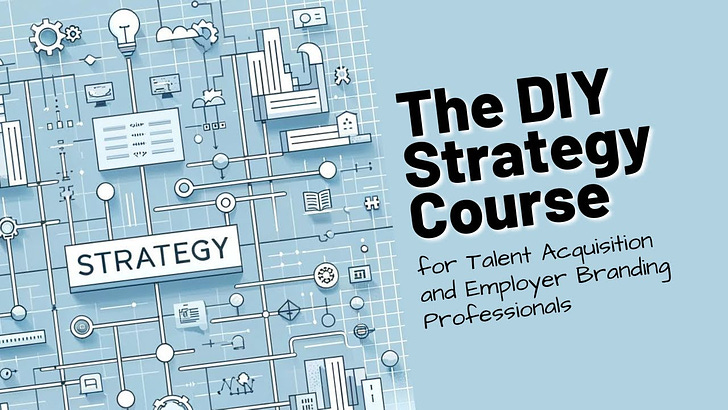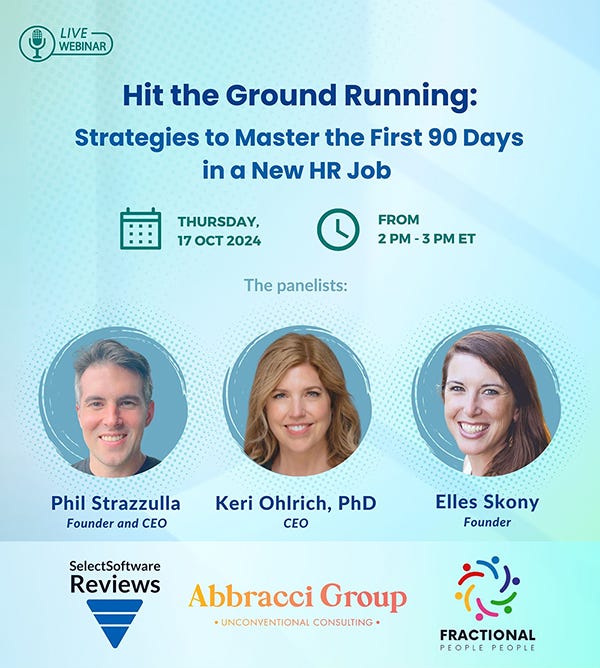Nail the First 90 Days in a New HR Role
Starting a new HR role in the near future? This webinar provides expert strategies and tips for you to excel in your new position.
The event will be co-hosted by industry veterans Phil Strazzulla, Founder and CEO of SelectSoftware Reviews, Keri Ohlrich. PhD, CEO of Abbracci Group, and Elles Skony, Founder of Fractional People People.
Topics on the agenda include:
Best practices for successful onboarding
Navigating company culture and building key relationships across departments
Assessing and aligning HR priorities with business goals
Identifying and prioritizing high-impact initiatives
Evaluating and improving existing HR processes and policies
Assessing and optimizing your dept’s existing resources and tech stack
Balancing quick wins with long-term planning
Bonus: Attendees can get personalized HR tech advice and recommendations from SelectSoftware Reviews’ experts, completely free of charge! Book your free HR Tech consultation today
[Sponsored]
You may have noticed that this emails/message/newsletter/thing didn’t land in your inbox at 7:20am Chicago time, as it has for almost two years.
Oh no!
Who cares?
But I bet that my open/read rate on this email will be higher than the average.
Why? Because I deviated from expectations.
Andy Clark wrote a whole book (The Experience Machine) about how the brain is mostly spending its energies predicting what’s about to happen, and really only “wakes up” when something deviates that expectation. When things adhere to the expectation, the brain yawns, thinks to itself “yep, all as expected” and goes back to… oh, I don’t know, wondering why you said that stupid thing in class when you were in sixth grade or something (your brain milage may vary).
That’s why comedy works: it creates a set up that suggests an obvious outcome and then takes a major left turn, violating that expectation.
That’s why we love clever ads and pretty career sites: they defy the expectation and force the brain to wake up and consider what it’s seeing.
Learning how to create those jarring surprises to attract attention and engage more of the brain is a smart skill to build.
But there’s another expectation game at work, one in which people expect things from you.
We all know employer brand is widely misunderstood even by those who think positively of it. Whether its the “pretty pictures and platitudes” approach, or the “We need an EVP! (even though we don’t know what to do with it)” approach, every single person at your company will enter every conversation and every meeting possessing a clear, considered expectation of what your job is, and what they should ask you for.
And most of them are wrong.
No two EB’ers are the same. They have different skills, different approaches, are focused on different goals and work for and with different teams. And if that’s true, how can someone on the outside understand what your unique and specific shape of employer branding is if you don’t inform them?
A large part of your job is setting expectations, both of the work you are doing and for the people around you. They need to understand that you’re a storyteller, not a videographer (or vice versa). They need to know you’re a strategist, not a social media manager (or vice versa). They need to know you are committed to increasing the level of quality among applicants, not increasing the number of applicants (or vice versa).
If they don’t know what you’re about and what you’re trying to accomplish, their brain will attempt to fill in the gaps (incorrectly).
Setting expectations starts with the (very) difficult step of defining yourself and your goals first. So employer branders float about, inserting themselves into recruiting or marketing issues, throwing out an idea or two, building a bit of content, and wonder why they are making no impact. It’s because no one knows what you’re here for (and how to use you) because YOU don’t know what you’re trying to accomplish.
So this weekend, grab an hour (where you can, I know how it is) and answer the following question to a level of specificity that stands up to scrutiny:
What are my employer brand/work super powers?
If I had to put myself in a bucket (social media expert, writer, designer, strategist, politician, manager, advocate, etc), what would it be? Max 2.
How does that superpower/bucket definition help someone?
What exactly am I trying to achieve this quarter/year (knowing that might keep me from doing something someone wants)?
Define that, and you will have gone a long way towards make it clear to others what their expectations should be.
And that sets you up for success.
I promise that if you better understand strategy and know how to build one, you will be obviously more effective at work. No, I’m not even kidding a little.
Subscriber note
Hi! I’m cooking something up for an early 2025 launch that I think you will absolutely LOVE. But I’m going to be coy for now (and yes, if you' aren’t thinking about 2025, you’re going to get caught flat-footed).
That means this newsletter in this form will be published in a more ad hoc fashion. Which means I won’t publish every week unless I have something useful to say. I want to push my towards this secret project so that it can have that impact on your work (and your boss’s work) it was meant to.
TL;DR: This newsletter will not be publishing on any set schedule through the end of the year. If you want a refund, I will remind you that no one pays for this, so there.
🌂 How to Keep Learning at Work — Even When You Feel Fried »
🌂 Is it time to get serious about influencer marketing? Yes »
🌂 Okay, I’ll just say it. 80% of your hiring managers suck at interviewing (in general) and 97% of them suck at interviewing using the brand. So yes, it is time to bring them into the fold »
🌂 Start by watching this short video about how social media marketing is dying (for realz!) from someone who legit knows. I suggest this because without the data points Rand Fishkin presents, you might see Kevin Wheeler’s article about the end of social recruiting as hyperbole. It isn’t »
🌂 Not strictly related to EB, but if we can see what they next generation of NEWS looks like, I bet it will help us change out old-school thinking about how people find, absorb, and act on information »
🏛️ All 2,500+ (five years worth!) articles from this newsletter are in a searchable archive. Go get ‘em!
Problem: You need to set better expectations
See the above section about setting proper expectations. How do you combat it? Write up your own boilerplate!
Boilerplate is that “copy/paste stuff” legal and comms use to describe the company in a clear and considered way without having to write it from scratch (and potentially messing it up) every time. So write one for your role. Maybe something like:
In a nutshell, employer brand is here to show off what makes this company different so that people can choose us (rather than just “look good",” which generally results in looking like everyone else). To achieve that, this function is focused on telling employer stories around the level of collaboration and support they get here [or use your own differentiated value here] via videos, testimonials and advocacy [insert your channel strategy here].
We know we are succeeding when we see an increased quality in our applicants and hires [OKR/KPI/ABC/BBQ/LOL here], which takes precedence over increasing our follower base on LinkedIn [or other common expectation people have].
Make it a a stick text and paste it wherever necessary.
2024 is winding down. I only have two more capacity for two more clients. If you’d like an employer brand that works for you in record time for a surprisingly low price, reply to this email and we’ll chat!
If you ask other people about every decision you make,
you're going to end up doing exactly what everyone else does
and getting the same results that everyone else gets.
- Shane Parrish
Four books and one audiobook
An employer brand buyers guide and agency listing
Six courses
150 videos
240 episodes of podcasts
Conversations on 23 podcasts
Seven “deep dive” resources
18 articles
All in one place: EmployerBrand.ing
I believe in giving knowledge away for free. But doing so isn’t free. So if you’d like to support the various costs for building all this content, please buy a book or hire me.
***This Newsletter Contains No ChatGPT***










